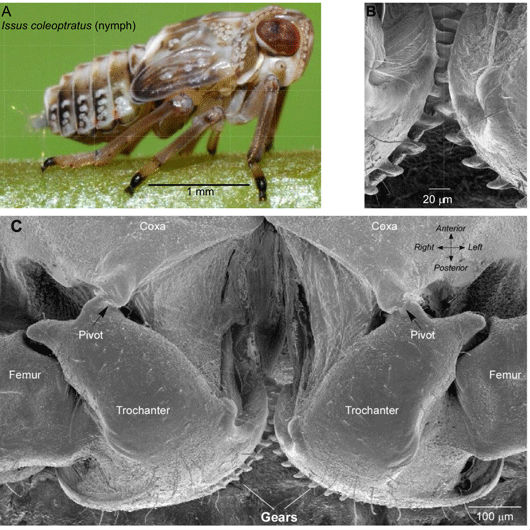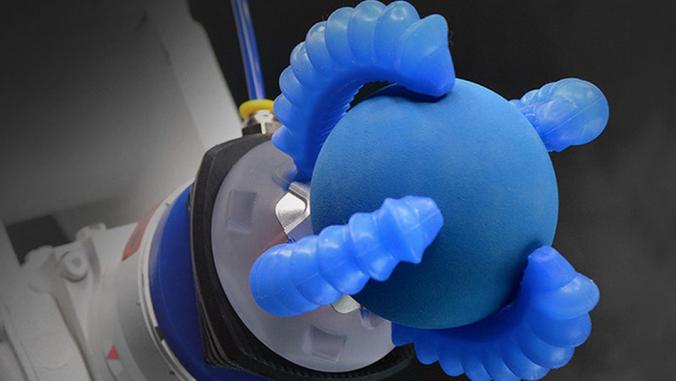Insect gears could change the way you look at engineering
<p><em>Issus coleoptratus</em> is an unlikely hero, but one whose jumping prowess could revolutionize ballistics and spring-loaded machines.</p>

Image of gears by Stefan W via Flickr
Nature is full of surprises. This is not in itself remarkable, as we know so relatively little about her inner workings. Our ignorance is put in stark relief, however, when one of our assumptions is challenged and we have to readjust our viewpoint of the world.
We humans are the masters of precision engineering. Whatever nature does, however successfully and even wondrously, must, we assume, be somewhat sloppy and wet and bendy. After all, we invented the wheel, didn't we? And make motors and airplanes while nature is still running around on horsepower. But is this feeling of superiority in precision really always justified?
A recent discovery in England shows that it is not, and the example is simultaneously understandable and hard to accept. In Science, Malcolm Burrows and Gregory Sutton (of the University of Cambridge and University of Bristol, respectively) describe a mechanism on the hind legs of a jumping insect that can only be described as a gear, cogs and all.
Although the structure had been seen before, their investigation of its action, using high speed cameras, has revealed its function: the first known case of an intermeshing gear mechanism that was not cast or forged, but that had evolved.
Precision engineering at the micron scale
Issus coleoptratus is a tiny but champion planthopper insect common in Europe. Not only can the creature jump a long way relative to its 6-millimeter size (sometimes as high as a meter), it also does this very quickly. Within two milliseconds of stimulus, it generates as much as 400 gs of acceleration and speeds of up to 6 meters a second.
Sutton explained this action in the recent article "Insect jumping, an ancient question" for the Human Frontier Science Program, a sponsor of his research. "This is far from easy, as these jumps require the insect to navigate three extremely difficult biomechanical challenges: 1) generating the necessary power, 2) directing the power through the legs to generate a controlled jump, and 3) synchronizing the two legs so that differential leg extension does not cause the animal to spin out of control. To solve these problems, evolution has developed biological structures that are strikingly similar to the man-made devices: composite bows, mechanical linkages, and most surprisingly, gears."
As when we pull back a bow, the insect slowly builds up elastic energy in its body and holds it in tension until the quick release allows the springiness of the material itself to amplify the force. You do it when you run down the street, using the tendons in your legs and feet to spring along. Kangaroos do it, and "even educated fleas do it" (apologies to Cole Porter).
This force, as powerful as it is, has to be translated to a form that will do work, and this is where the mechanical linkages come in to play. Planthoppers use a small muscle in the femur/tibia joint of their leg to redirect the force of the unbending body. One leg powers the move and the other determines direction. The bug still has one challenge left, however, and that is synchronizing the two legs.
 The researchers found that in its nymphal phase I. coleoptratus uses the equivalent of a spur gear to aid its record-breaking leaps. Burrows and Sutton initially had surmised that there must be some mechanical structure to do this, because the time was too fast to be triggered by nerve impulses, which typically would happen in the range of five to six milliseconds.
The researchers found that in its nymphal phase I. coleoptratus uses the equivalent of a spur gear to aid its record-breaking leaps. Burrows and Sutton initially had surmised that there must be some mechanical structure to do this, because the time was too fast to be triggered by nerve impulses, which typically would happen in the range of five to six milliseconds.
There was. I. coleoptratus tucks its rear legs underneath its body and on each leg on the second joint away from the body (trochanter) is a geared strip that meshes with its mate when the animal ratchets its legs to cock its body for the spring. This meshing prevents the animal from spinning to one side as the animal would do if the legs did not fire at precisely the same time. As it turns out, this is very precise indeed: the legs spring within 1/300,000 of a second of each other. This yaw control is an important advantage to a creature that needs to land on target to reach food or escape predators.
The strips have 10 to 12 gear teeth, asymmetric in their form, looking like shark fins on just a portion of a circle. Each tooth is about 50 microns in width and 15 to 30 microns in length and about 30 microns apart from its neighbors. Like so many parts in nature, these, too, are made from a composite for both hardness and durability: in this case, chitin, that sugar-based polymer of choice in the insect world, and sclerotin, a protein.
Current suppositions hold that, like most jumping insects, I. coleoptratus may have started out with coordinating its jumping legs using friction alone; having rough areas on its legs that gradually were naturally selected as a patterned roughness that turned into the more precise cogs. The more precise mechanism enabled a more accurate landing, which might have been a huge advantage to Issus but not to the majority of other jumpers, who, obviously, did not wander down that evolutionary path.
I. coleoptratus jettisons this advantage in its final molt, and the adult employs the more common friction pad to time its spring action. The researchers posit that this might be because of the irrevocable loss of function from a broken tooth should the now-no-longer-growing animal have an accident. They further speculate that the unusual asymmetry might be an advantage in managing wear and tear in repetitive motion that has limited degrees of freedom.
Possible applications
For co-discoverer Sutton, this adaptation bespeaks a selective specialization that holds lessons for human technologists. "The gears," he says, are built for "high precision and speed in one direction. It's a prototype for a new type of gear." Asymmetric spur gears also can be an advantage if more load capacity is wanted for less weight and size.
 In the world of human technology, gears are typically radial and symmetric, the so-called involute gear invented by famous Swiss mathematician Leonhard Euler. They can be configured in any number of geometrical arrays so that they mesh together. The universal transaxle gears on your car are good examples. Asymmetrical spur (or cogged) wheels similar to the insect variety are comparatively uncommon.
In the world of human technology, gears are typically radial and symmetric, the so-called involute gear invented by famous Swiss mathematician Leonhard Euler. They can be configured in any number of geometrical arrays so that they mesh together. The universal transaxle gears on your car are good examples. Asymmetrical spur (or cogged) wheels similar to the insect variety are comparatively uncommon.
If a high-load, unidirectional application requires precision and speed, it seems that this type of gear might be a good candidate for further development. Ballistics certainly comes to mind, as does anything currently spring-loaded: locks or openers for water or air tight doors, emergency heaving line or lifeboat launchers, repetitive force tools.
One key, of course, would be the amount of energy able to be stored by the device's material and the amplification produced relative to the force needed. In that regard, nature seems to have us beat, at least in regard to common materials. Collagen, that natural protein in your tendons and bones, according to Dr. Steven Vogel, professor emeritus of Duke University, can hold 20 times the energy relative to its weight than spring steel.
Is it also possible that we might learn other things from I. coleoptratus? Burrows and Sutton point out that the teeth on the cam-like strips have curved fillets at their base that reduce the likelihood of their shearing off, very similar to machined parts. They also suggest that the composite material in the teeth is functionally graded with a greater amount of protein in the mix where durability is needed over hardness. This is a common strategy in nature and it is evident in your own bone.
In nature and technology we have seen a long use of elastic stored energy to do work, particularly when speed and powerful force were required. Using the inner structure of the material and time to first store and then amplify force means saving energy in achieving extreme performance. Sound necessary in the work that you do? Maybe we should all take a closer look at that little bug, Issus coleoptratus.
Top image of gears by Stefan W via Flickr.





